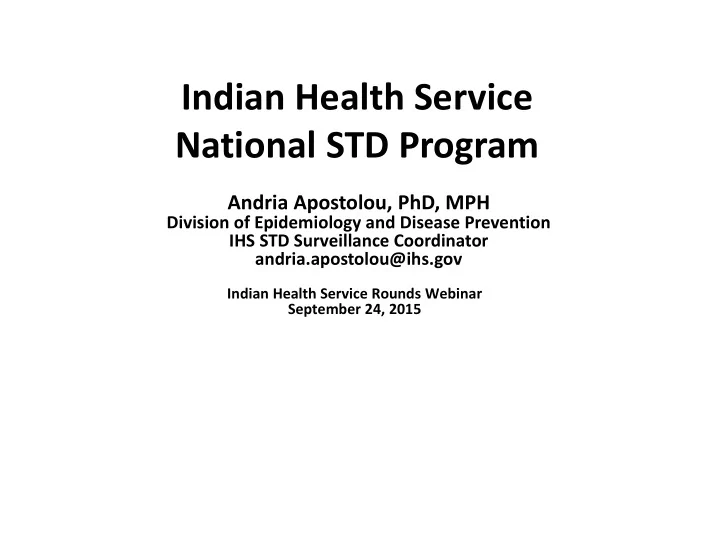

Indian Health Service National STD Program Andria Apostolou, PhD, MPH Division of Epidemiology and Disease Prevention IHS STD Surveillance Coordinator andria.apostolou@ihs.gov Indian Health Service Rounds Webinar September 24, 2015
Disclosure I do not have any financial arrangement related to the content of this activity
Sexually Transmitted Diseases (STDs) • 20 million new cases of STDs occur in the U.S. each year • AI/AN bear a disproportionate burden • Chlamydia & gonorrhea rates among AI/AN are ~4 times those of non-Native whites – During 2009 — 2013, the rates of chlamydia and gonorrhea among AI/ANs rose by 23.9% and 87.4%, respectively • Syphilis and human immunodeficiency virus (HIV) also have disproportionately higher impact on AI/ANs • Serious health consequences of unrecognized STDs, including infertility, might occur without prompt diagnosis & treatment • Half of all STDs occur in those under 25 years of age – This age group represents only one quarter of those that are sexually active
Chlamydia Rates by Race / Ethnicity, United States, 2004 – 2013 Centers for Disease Control and Prevention. Sexually Transmitted Disease Surveillance 2013. Atlanta: U.S. Department of Health and Human Services; 2014.
Chlamydia Rates by Sex and Age, AI/AN Non-Hispanic, 2011 Centers for Disease Control and Prevention and Indian Health Service. Indian Health Surveillance Report — Sexually Transmitted Diseases 2011 , Atlanta, GA: US Department of Health and Human Services, June 2014. http://www.cdc.gov/std/stats/ihs/ihs-surv-report-2011_062314.pdf
Gonorrhea Rates by Race / Ethnicity, United States, 2004 – 2013 Centers for Disease Control and Prevention. Sexually Transmitted Disease Surveillance 2013. Atlanta: U.S. Department of Health and Human Services; 2014.
Gonorrhea Rates by Sex and Age, AI/AN Non-Hispanic, 2011 Centers for Disease Control and Prevention and Indian Health Service. Indian Health Surveillance Report — Sexually Transmitted Diseases 2011 , Atlanta, GA: US Department of Health and Human Services, June 2014. http://www.cdc.gov/std/stats/ihs/ihs-surv-report-2011_062314.pdf
Primary and Secondary Syphilis Rates by Race / Ethnicity, United States, 2004 – 2013 Centers for Disease Control and Prevention. Sexually Transmitted Disease Surveillance 2013. Atlanta: U.S. Department of Health and Human Services; 2014.
Primary and Secondary Syphilis Rates by Sex and Age, AI/AN Non-Hispanic, 2011 Centers for Disease Control and Prevention and Indian Health Service. Indian Health Surveillance Report — Sexually Transmitted Diseases 2011 , Atlanta, GA: US Department of Health and Human Services, June 2014. http://www.cdc.gov/std/stats/ihs/ihs-surv-report-2011_062314.pdf
STDs: Screening and Treatment • STDs can be asymptomatic • Screening & treating people with STDs & their partners are key strategies for preventing new infections • CDC released the 2015 Treatment Guidelines in June 2015 – This updates the 2010 Treatment Guidelines • Best practices to improve screening and treatment have been shown to improve clinical management of STDs & increase overall screenings for targeted groups – Automated electronic health record screening reminders – Standing orders for screening – Expedited Partner Therapy (EPT)
IHS STD Program: Mission • The mission of the IHS National STD Program, in partnership with American Indian/Alaska Native people, is to raise their physical, mental, social, and spiritual health to the highest level possible through prevention and reduction of sexually transmitted diseases
IHS STD Program: Goals • Raise awareness of STDs as a high priority health issue • Support partnerships and collaborations with state STD programs, IHS, tribal, urban Indian (I/T/U), and other public health agencies • Support improvement of I/T/U, state, and local STD programs for AI/AN • Increase access to up-to-date STD training for clinicians and public health practitioners • Support and strengthen surveillance systems to monitor STD trends • Promote STD research and identify effective interventions for reducing STD morbidity • Support STD outbreak response efforts • Support integration of STD/HIV/AIDS and hepatitis prevention and control activities
Why Track STD Clinical and Surveillance Data? • Provides evidence of progress towards targets and goals • Assists in evaluating effectiveness of interventions • Provides opportunities for dialogue to share lessons learned among Service Units and Areas • Can provide tailored feedback to Service Units and Areas that might be unaware of national or local/internal data • Other national initiatives track these measures e.g. GPRA, Healthy People 2020 • Other national partners track these data e.g. CDC, state and local health departments
IHS STD Program: Recent Activities • Surveillance of STDs – Surveillance report published every two years in collaboration with CDC – State STD morbidity (CT, GC, P&S syphilis) analyzed by IHS Areas – Available online http://www.cdc.gov/std/stats/ihs/default.htm
IHS STD Program: Recent Activities • Surveillance of STDs – Surveillance report published every two years in collaboration with CDC • Monitoring performance using CRS/GPRA national measures – HIV screening 13 — 64 years of age (GPRA)* – Prenatal HIV screening – Annual chlamydia screening among women between 15-25* – HIV screening for STD+ patients – HCV screening for baby boomers* * EHR reminder available
IHS STD Program: Recent Activities • Surveillance of STDs – Surveillance report published every two years in collaboration with CDC • Monitoring performance using CRS/GPRA national measures – HIV screening 13 — 64 years of age (GPRA)* – Prenatal HIV screening – Annual chlamydia screening among women between 15-25* – Goal: 60%; only about 34% are screened – HIV screening for STD+ patients – HCV screening for baby boomers* * EHR reminder available
IHS STD Program: Recent Activities • Surveillance of STDs – Surveillance report published every two years in collaboration with CDC • Monitoring performance using CRS/GPRA national measures – HIV screening 13 — 64 years of age (GPRA)* – Prenatal HIV screening – Annual chlamydia screening among women between 15-25* – HIV screening for STD+ patients – HCV screening for baby boomers* • Provide support and guidance during outbreak investigations • Promote evidence based best practices • Increase training of medical providers • Perform site assistance visits *EHR reminder available
http://www.ihs.gov/epi/index.cfm?module=epi_std_main
http://www.ihs.gov/listserv/topics/signup/?list_id=167
http://www.ihs.gov/listserv/topics/signup/?list_id=167
Recommend
More recommend